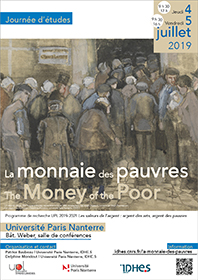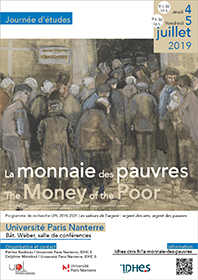Version française / Équipe / Chercheurs, Enseignants-chercheurs
- Libellé inconnu,
La monnaie des pauvres

Journée organisée par l'IDHES dans le cadre du projet 2019-2021 « Les valeurs de l’argent : argent des arts, argent des pauvres » financé par la Comue Université Paris Lumières.
du 4 juillet 2019 au 5 juillet 2019
Bâtiment Max Weber (W)
Pour assister à la journée, merci de vous inscrire auprès de Patrice Baubeau : patrice.baubeau@parisnanterre.fr
Aim of the Workshop
But des journées d'étude
Programme
Jeudi 4 juillet 2019
9 h Accueil
9 h 30 – 12 h 30 1re session
Présidence : Jérôme Blanc | Sciences Po Lyon
Introduction générale
Patrice Baubeau | Université Paris Nanterre, IDHE.S
Jérôme Jambu | BNF, département des monnaies, médailles et antiques
Une économie monétaire chez les esclaves antillais ?
Ekaterina Svirina | National Research University Higher School of Economics (NRU Higher school of Economics)
Money of the poor in the Russian Empire: study of the official documents and travel notes dated back to 19th c.
Mathieu Bidaux | Université de Rouen, GRHis
Les billets de la Banque de France (1830-1857) : une monnaie de riches employée par les pauvres ?
Thibault Cardon | CNRS, Université de Caen Normandie, CRAHAM – Centre Michel de Boüard
Le contrôle social par l’argent : les « monnaies de camp »
13 h 30 – 16 h 30 2e session
Présidence : Akinobu Kuroda | Tokyo University
Hisashi Takagi | Yasuda University
Means of exchange in small transactions in the 16th century Japan: lower class bronze coin, silver currency, and credit use
Catherine Brégianni | Academy of Athens, Modern Greek History Research Centre
Minor coins and major historiographical problems: the 1893’s Greek Default from a monetary perspective
Maria Stella Chiaruttini | Institut universitaire européen (Florence)
“Change of silver coins is an inexpressible agony in these places”: The money of the poor and Italian unification
Jan Lucassen and Rombert Stapel | International Institute of Social History, Amsterdam
The 1828 withdrawal of old coppers in the Netherlands
Vendredi 5 juillet 2019
9 h 30 – 12 h 30 3e session
Présidence : Jan Lucassen | International Institute of Social History, Amsterdam
Rila Mukherjee | University of Hyderabad, Gachibowli (Inde), School of Social Science
The Pervasiveness of A “Poors’ Money” in Bengal: 13th to the 20th centuries
Sophie Laligant | Université de Tours, CITERES et Jordy Sio | Université de Tours
L’argent, l’igname et le qëmek dans la petite coutume en Métropole
Patrice Baubeau | Université Paris Nanterre, IDHE.S et Emmanuel Prunaux | Banque de France, EHESS
Banques de sols et monnaies de cuivre : les ambiguïtés de la circulation des « mauvaises monnaies »
Ismael Moya | Université Paris Nanterre, MAE, LESC
Quelques éléments sur l’argent et la finance populaire à Dakar
Akinobu Kuroda | Tokyo University
A Monetary Unification Neglecting the Ground Level: Myth of Unified Money in 1935 China
13 h – 16 h 4e session
General debate
Présidence : Georgina Gomez | Erasmus University Rotterdam
Currencies and Monies of the Poor:
– Archives, sources and documentation
– Indirect evidences
– Narratives origins and biases
Monies of the Poor and wealth circulation:
– The wage circuits
– The consumption circuits
– The credit circuits
– The ethical/social/communal circuits
Monies of the poor vs monies of the rich:
– Usage costs differences
– A quality ladder model of monetary usages and consumption?
– Social and gendered assignation of monetary uses
– Distinction through money: prestige and inclusiveness properties of money
What’s next:
– Paris WEHC 2021
– Book publication
– Journal publication
Iconography The Poor and Money

Vincent van Gogh (1853 – 1890)
The Hague, September-October 1882
Chalk, watercolour, pen and ink, on paper, 37.9 cm x 56.6 cm
Credits : Van Gogh Museum, Amsterdam (Vincent van Gogh Foundation)
Vincent had commented on portraying groups in an earlier letter: “how hard it is to get life and movement into it, and to get the figures in place and separate from each other.”
DRAWING FOR NATIONAL LOTTERY TODAY
Iconographie Les Pauvres et l'argent
Vincent van Gogh (1853 – 1890)La Haye, septembre-octobre 1882
Craie, aquarelle, plume et encre, sur papier, 37,9 cm x 56,6 cm
Crédits : Musée Van Gogh, Amsterdam (Fondation Vincent van Gogh)
TIRAGE DE LA LOTERIE NATIONALE AUJOURD’HUI
Vincent avait fait des commentaires sur la représentation des groupes dans une lettre antérieure : « Comme il est difficile d’y faire entrer la vie et le mouvement, de mettre les figures en place et de les séparer les unes des autres. »
- Université Paris Lumières
- IDHES
Mis à jour le 08 juillet 2019












